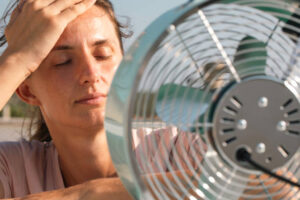It’s officially the hottest day of the year in England, with temperatures surpassing 30C and amber heat health alerts in place as we enter an early summer heatwave.
 Climbing temperatures have brought warnings for schools, businesses and communities to protect people’s health, safety and welfare, particularly those who may be more vulnerable to the heat.
Climbing temperatures have brought warnings for schools, businesses and communities to protect people’s health, safety and welfare, particularly those who may be more vulnerable to the heat.
The UK Health Security Agency (UKHSA) issued heat health alerts for the whole of England on Monday morning, warning that health and social care services across the country could face increased pressures and demand throughout the heatwave.
Today has seen temperatures range from 27C to 30C across east Wales, the Midlands, and East and South East England, while parts of Greater London and the home counties have seen the mercury rise to 31C.
Yellow heat health-alerts were already in place, but this week’s heatwave has seen alerts raised to amber.
Heatwave brings health risks to UK population
 The UKHSA and the Met Office coordinate the alert system, focusing on health risks posed by extreme temperatures. There are four levels of warning: green, yellow, amber and red. Amber alerts indicate that hot weather is likely to impact the health service.
The UKHSA and the Met Office coordinate the alert system, focusing on health risks posed by extreme temperatures. There are four levels of warning: green, yellow, amber and red. Amber alerts indicate that hot weather is likely to impact the health service.
The UKHSA warns that there may be difficulties managing medicines, delivering services and maintaining safe temperatures in care settings during the heatwave. They have also warned of a potential increase in deaths, particularly among people aged 65 or over or those with health conditions.
But there are also general health risks to the wider population during the heatwave.
It is likely that temperatures tomorrow (Friday 20th June) will vary from the mid to high twenties across the UK, with some locations in the Southeast seeing temperatures climb past 30C again.
The heatwave has been caused by an area of high pressure across the UK which, coupled with a south-easterly wind, has drawn in hot water from other parts of Western Europe.
A mixed picture is expected on Saturday, with Northern and Western locations experiencing a fall in temperatures and possibly some rain and thunderstorms, while the heatwave is expected to peak in central and eastern England. In these regions, temperatures could reach as high as 34C this weekend.
The heatwave is expected to break for all regions of the UK by Sunday, with a westerly wind ushering in cooler temperatures.
What is a heatwave?
The official heatwave threshold varies across different regions of the UK. Locations must record temperatures exceeding their threshold temperature for at least three consecutive days for the Met Office to declare an official heatwave.
Today has seen places in Lincolnshire and Suffolk hit this criteria, after three consecutive days where the mercury has risen past 27C.
The threshold in the north and west of the UK is slightly lower, at 25C, but rises to 28C in parts of eastern England.
The UK heatwave has also prompted regional fire services to issue water safety warnings.
The Assistant Commissioner for Prevention and Protection at the London Fire Brigade, Pam Oparaocha, warned people who might be tempted to cool off in local waterways that strong currents, underwater hazards and cold water shock can prove “deadly.”
She added:
“With warm weather and school holidays on the horizon, we want people, especially young people, to enjoy our waterways safely, and that starts with education.
“It’s important to know the risks and to familiarise yourself with lifesaving equipment like throwlines, which are available along many of London’s waterways.”
Protect vulnerable individuals during the heatwave

Meanwhile, many national organisations have issued advice and guidance to help protect the health, safety and welfare of vulnerable individuals during the heatwave,
The British Heart Foundation warned that hot weather can place extra strain on the heart, so warned those with heart conditions to take precautions, while Age UK urged people to check in on older people who may struggle in high temperatures.
Schools and childcare providers across the UK have also taken measures, such as allowing children to attend school in their PE kits rather than standard uniform, and reminding parents to provide children with suncream, a sunhat and a refillable drinks bottle.
Is it too hot to work?
 In workplaces, employers have a legal duty to protect the health, safety and welfare of their staff all year round, whatever the weather.
In workplaces, employers have a legal duty to protect the health, safety and welfare of their staff all year round, whatever the weather.
During the current heatwave, the Health and Safety Executive (HSE) has reminded businesses and organisations about its guidance on managing workplace temperatures.
Britain’s health and safety watchdog provides useful information and advice about protecting workers during hot weather, particularly those working outdoors, and preventing dehydration and heat stress.
They emphasise that there is no legal maximum working temperature, as every workplace is different.
The onus is on employers to ensure that employees can work safely in current weather conditions, and they should conduct a basic risk assessment to identify the potential risks posed to workers from hot weather while at work and implement suitable control measures. These could include:
- Ensuring windows can be opened or closed
- Providing fans to cool the air
- Installing and maintaining air conditioning units
- Introducing flexible hours or early / late starts to avoid high temperatures
- Relaxing formal dress codes
- Insulating hot machinery or pipes
- Moving workstations away from hot machinery or out of direct sunlight
The HSE’s workplace temperature checklist will help employers complete their heatwave risk assessment.
General welfare advice during a heatwave
General health, safety and welfare advice from the UKHSA for hot weather and heatwaves includes:
- Stay cool indoors by closing curtains in rooms that face the sun. Keep windows shut during the day and open them in the evening, when temperatures cool
- Drink plenty of fluids, and avoid alcohol
- Keep out of the sun between 11am and 3pm when it’s rays are at their strongest
- Stay in the shade, use suncream with a high SPF and UVA rating and wear a wide brimmed hat
- Avoid physical exercise during the hottest times of day
- Carry water with you when you’re out and about
During hot weather, it’s important to be aware of the symptoms of heat exhaustion, which can be triggered by a loss of fluids and salts from the body and a drop in blood pressure. These include:
- Dizziness
- Nausea
- Fainting
- Confusion
- Muscle cramps
- Headaches
- Heavy sweating
- Tiredness
If blood pressure drops too far, the risk of heart attacks rises. This is one of the reasons why the British Heart Foundation has issued warnings for people with heart conditions.
Sensory differences and hot weather
 A heatwave can bring challenges for everyone. Individuals who may experience additional struggles during a heatwave or very hot weather are autistic or neurodiverse individuals.
A heatwave can bring challenges for everyone. Individuals who may experience additional struggles during a heatwave or very hot weather are autistic or neurodiverse individuals.
Many autistic or neurodivergent people can experience sensory processing differences, and heat may have a profound effect on their wellbeing, concentration and safety.
Sensory differences may include hypersensitivity and hyposensitivity to heat.
- Hypersensitivity = intense discomfort or distress in response to heat
- Hyposensitivity = reduced awareness of overheating or dehydration
If you’re working with or supporting autistic people or individuals with a neurodiverse condition during high temperatures, try to:
- Check in with them, gently and often
- Provide cool spaces, fans, and water
- Watch for non-verbal signs like fatigue, zoning out, or agitation
- Respect everyone’s needs, visible or not
First Response Training (FRT) has developed a free guide to supporting autistic people with heat sensitivity.
This includes non-verbal signs of overheating and measures to support sensory differences in hot weather, such as providing flexibility in routines and building in opportunities to rest.
The national training provider works with many autistic people as Experts with Lived Experience to co-deliver the Oliver McGowan Mandatory Training Framework on Learning Disability and Autism.
A member of the FRT team says:
“We want to extend a heartfelt thank you to all of our autistic co-trainers who are delivering powerful training sessions in difficult conditions as Experts with Lived Experience.
Their training really makes a difference, and perhaps will help learners understand how much of an impact things like hot weather can have on autistic individuals.”
FRT were one of the first training providers to be approved to deliver the Oliver McGowan Mandatory Training on Learning Disability and Autism. They have also developed their own flexible training programme which is co-delivered with experts with lived experience, meets all recommended learning objectives and is fully compliant with the requirements of the Health and Care Act 2022.
Protecting people’s health, safety and wellbeing at work
The provider also offers a wide range of quality workplace training courses in the fields of health and safety, first aid, fire safety, food safety, mental health, health and social care and other special focus topics.
They have also developed specialist neurodiversity training courses such as Introduction to the Autistic Spectrum, Working with Autistic People, Learning Disability and Autism, ADHD Awareness, Dyslexia Awareness, SEND Awareness and Equality, Diversity and Inclusion.
Based on a common sense, proportionate approach to workplace health and safety, training helps learners to understand the true benefits of creating a wellbeing culture at work.
A trainer from FRT explains:
“We believe in creating safer working environments with people who care, and know that when workers feel safe, valued and protected, they are likely to be happier and more productive at work.
“Companies with a strong health, safety and welfare ethos can not only reduce workplace accidents and downtime, but also see better staff retention rates and increased employee satisfaction in the future.
“Training can help employers understand their responsibility to assess risks to workers, consult with workers on control measures to reduce those risks, and implement those measures. This applies to measures to maintain a comfortable, safe temperature for all workers during a heatwave as well as many other welfare factors.”
For more information on any of the training courses that FRT can provide, please call them today on freephone 0800 310 2300 or e-mail info@firstresponsetraining.com.
